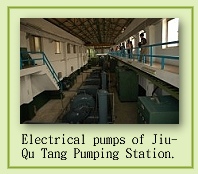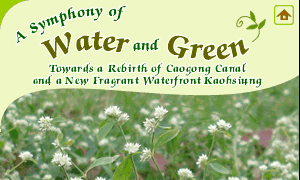the History of Canal Construction
 Caogong Canal is seen as one of the three most important hydro-engineering structures during Ching administration in Taiwan. In 1837, Cao Jin assumed the Fong Shan County magistrate under orders. Upon his first official arrival, he previously visited the city mayor, Xiong, Yi-Ben. Mayor Xiong told him that sufficiency would naturally appease criminal pressure and he supposed that most farming fields within Fong Shan County belonged to the fields with harvest critically depending on rainfall. Once the rainfall was sufficient, there would be a good year; otherwise, people would subsequently suffer starvation with criminal pressure increasing. Thus, Mayor Xiong requested Cao to firstly solve the irrigating issue and Cao really kept this wise advice in his mind. Caogong Canal is seen as one of the three most important hydro-engineering structures during Ching administration in Taiwan. In 1837, Cao Jin assumed the Fong Shan County magistrate under orders. Upon his first official arrival, he previously visited the city mayor, Xiong, Yi-Ben. Mayor Xiong told him that sufficiency would naturally appease criminal pressure and he supposed that most farming fields within Fong Shan County belonged to the fields with harvest critically depending on rainfall. Once the rainfall was sufficient, there would be a good year; otherwise, people would subsequently suffer starvation with criminal pressure increasing. Thus, Mayor Xiong requested Cao to firstly solve the irrigating issue and Cao really kept this wise advice in his mind.

After Cao backed to the Fong Shan County, he started to take inspection tours on farming fields. When he arrived at Jiu Qu Tang and saw the running stream water of Xa Dan Shui Stream (currently known as Kaoping Stream), he exclaimed forerunners' wasting behaviors toward running stream water generously allowed by God.
Thus, Cao decided to construct the irrigating canal. In summer of the same year, he started to recruit artisans for canal construction. At Jiu Qu Tang, he established the embankment and water gates with upstream water introduced. In winter of 1838, the engineering was completed available for irrigating water circulation. The canal was roughly 14,500 meters long with irrigating limits reaching 3000 hectares above. The arid fields finally became the ones with ample crops. The crop productivity had been improved from harvest once a year to twice a year. People were fed well and no more criminal attention was triggered. Every household could enjoy their calling and life peacefully.

In winter of the same year, in response to the appeal made by people in Fong Shan, Mayor Xiong established and named the monument for canal engineering and people all attributed this success to Cao's capabilities and effort. Hence, Xiong agreed to allow this irrigating canal named after Cao and officially inscribed the Caogong Canal Epigraph on the monument. The said monument is now kept at Cao's Temple for commemoration of offsprings.
In 1841, Fong Shan County suffered drought again. At the time, Cao had been promoted to the coastline guard director in the Dan Shui Hall. Under his order, Zheng Lang and Zheng Xuan Zhi were dispatched to construct other irrigating canals with farmers within the areas from Jiu Qu Tang to Cao Tan. They spent 3 years completing the engineering and the canal was titled as the New Caogong Canal and the former one was called Old Caogong Canal. These 2 canals made the arid fields within Fong Shan County area become the fields with sufficient irrigating water remarkably beneficial for large numbers of inhabitants.

( Picture provided by Kaohsiung Museum of History)
At present - 170 more years later, the Caogong Canal still moisten the arid land within the Great Kaohsiung Area. No matter in civil, irrigation or industry water, there are actually 2 million more people under its moistening benefit. Thus, the generosity and charity extended by Cao's effort on canal construction is worthy of descendants' gratitude in mind.
Reflection
Cao Jin was an excellent and generous magistrate. The Caogong Canal constructed by him really benefits to Kaohsiung inhabitants at all times. Especially, at the day confined by material shortage, there were no any mechanical equipment available, and people had to use their labor for canal construction. Thus, we should take good care of the Caogong Canal and prevent it from damage and pollution. Thus, the effort made by the forerunners would never be futile finally.
|

